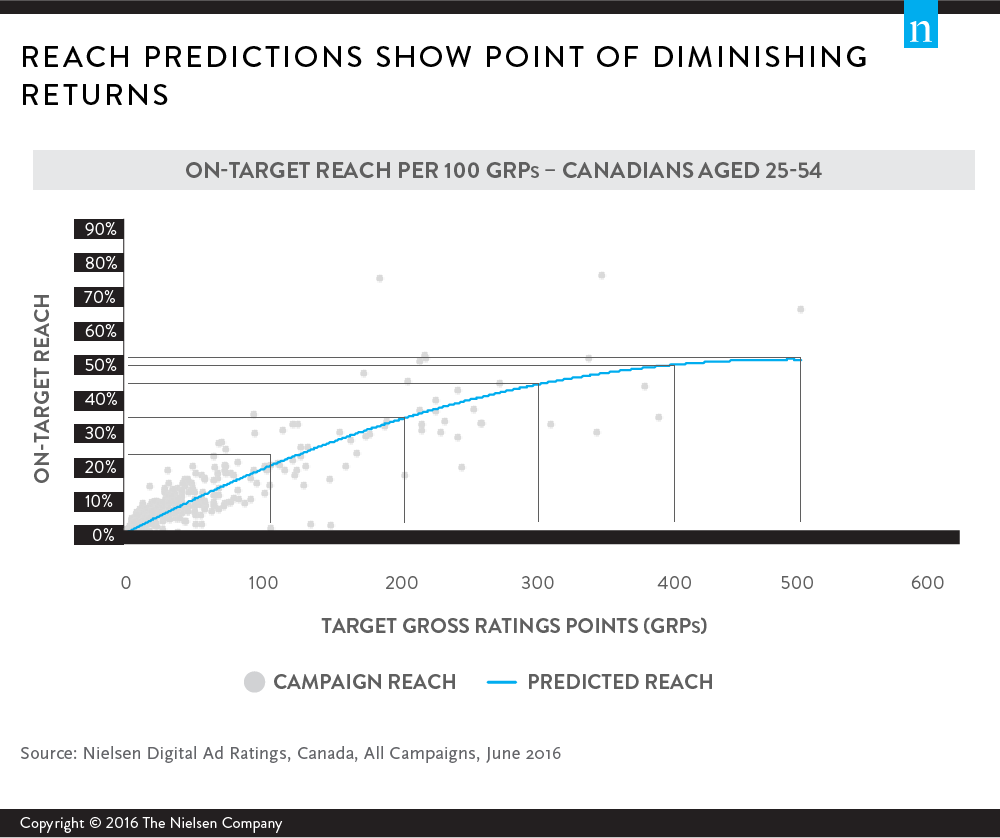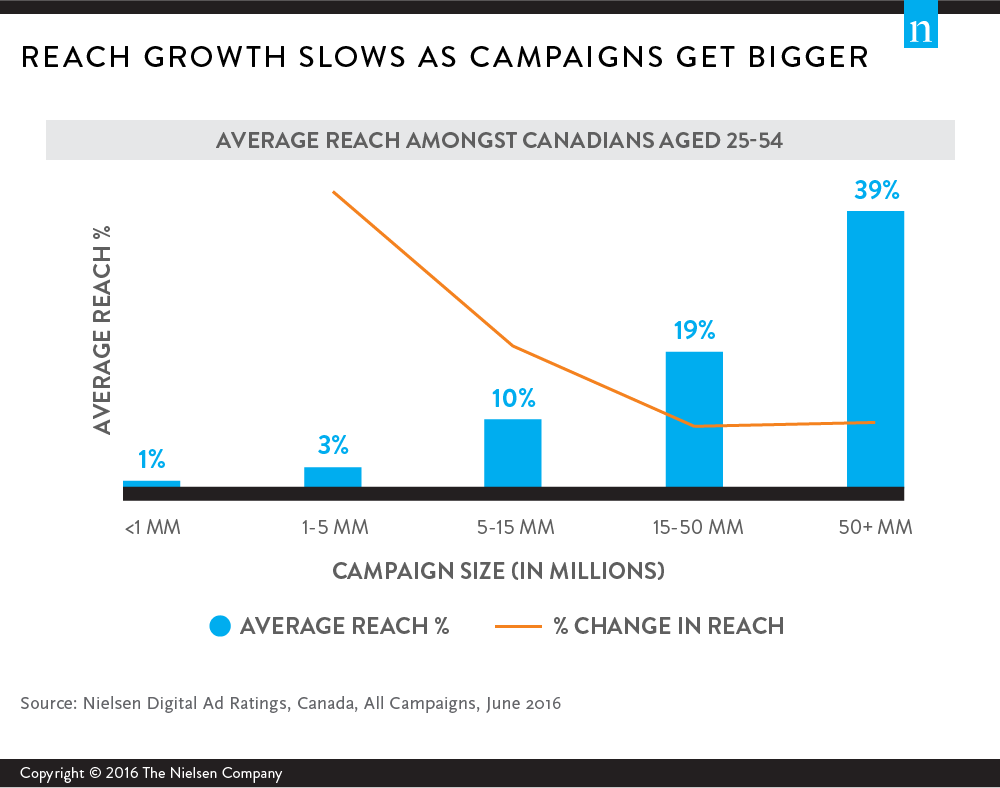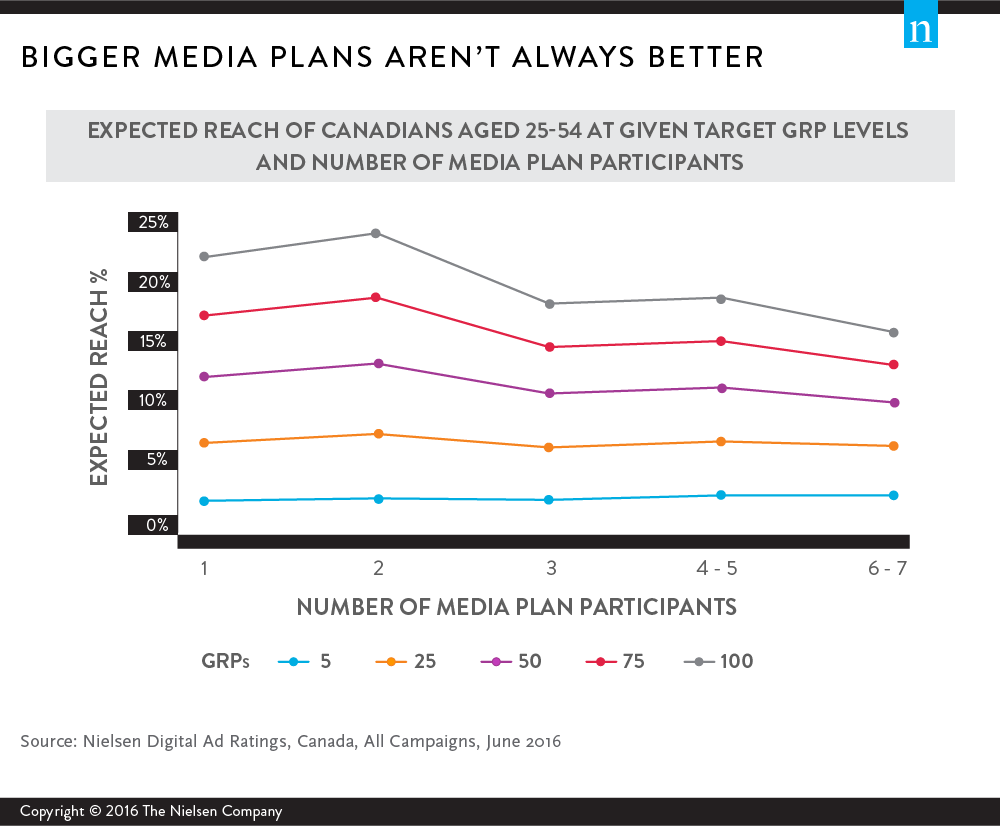Who should you include on your media plan? That’s the question media planners face on a day-to-day basis. As we turn our sights to 2017, many agencies will be relying on the following assumptions to reach their audiences for everything from one-day takeovers to year-long campaigns:
- The most efficient way to reach your audience is to deliver as many campaign impressions as possible to your desired audience.
- Campaigns with more impressions will reach more of your desired audience.
- Having more publishers on your media plan will increase your chances of reaching more of your audience.
While these assumptions may work if you have money and impressions to burn, Nielsen has found that there can be too much of a good thing when it comes to reaching your audience.
For the past three years, Nielsen Digital Ad Ratings has been helping Canadian marketers and publishers understand how well their campaigns are reaching their desired audiences. The upside is that performance is improving. In fact, on-target percent, or the percentage of impressions that were actually served to the desired audience out of the total campaign impressions, increased to 84% this year from 76% in 2015 for broad audiences. In other words, campaigns geared toward mixed male and female audiences that span more than 30 years in age reached their audience 84% of the time. Increasing on-target percentage shows that independent, transparent third-party metrics aren’t just useful because they measure performance, but that they can be acted on to improve performance.
So, Canadian marketers are reaching more of their audience. That’s everything right? Unfortunately, reaching the right people is just the beginning. Next, you have to reach them efficiently.
Reach efficiency is a measure of how effectively a given website delivers unduplicated reach. For example, showing your ad once to 10 different people is unduplicated reach, whereas showing your ad 10 times to the same person is duplicated reach. We recently talked about reach efficiency in Canada, but to quickly summarize, reaching your audience efficiently means that you are trying to reach the largest unduplicated audience possible and showing your ad to them the least amount of times possible.*
But how do you control this? Each publisher has a unique “reach build rate,” or how efficiently that publisher is able to build unduplicated reach. Surprisingly, biggest doesn’t always win.
Smaller campaigns can actually build unduplicated reach more efficiently than very large campaigns. As campaigns get larger, they reach a natural point of diminishing returns.

The chart above shows the predicted reach curve for mixed female and male audiences aged 25-54. This curve is based on historical performance, and shows the predicted reach, or the percentage of the intended audience the campaign is likely to reach, based on the campaign’s gross ratings points (GRPs), or how big the campaign is. For a campaign that is 100 GRPs focused on people aged 25-54, one can expect to reach approximately 20% of the intended audience. When that campaign is twice as big, 200 GRPs, reach goes up to approximately 34% of Canada’s 25-54 year olds. In other words, when you double the campaign size, reach increases by 70%. However, for the next increase of 100 GRPs, from 200 to 300, predicted reach only increases by 29%. For the next hundred GRPs, from 300 to 400, predicted reach growth slows down to only a 16% increase, before plateauing at the next 100 GRPs, only growing by 2%. With that much exposure, it becomes challenging to find someone who hasn’t already seen your ad, so your ad is delivered to the same audience repeatedly, causing frequency to grow faster than reach.
It gets harder to reach unique people as your campaigns get larger. While this may seem counterintuitive, the reality actually makes a lot of sense. Canada has a population of roughly 36 million. When you have a small campaign, let’s say 1 million impressions, it’s easy to reach people who haven’t seen your campaign before. In fact, you only have a one in 36 (2.8%) chance of showing your campaign to the same person. This is not to imply that small campaigns will never show the ad to the same person twice – on average, campaigns geared towards people aged 25-54 that are 1 million impressions or less show the same ad around two to three times to the same person in the course of a campaign. However, it’s certainly easier to reach unduplicated audiences and keep the frequency with which you are showing the same people the same ads relatively low.
As the campaign gets larger, however, how quickly reach can build drops. We’ve found that for a campaign that is 15 million impressions, you only reach 155 unduplicated people per 1,000 impressions, which means people see your ad six times on average. Your chances of reaching the same person is now five in 12 (41.7%). That’s because as the campaign gets larger, it gets harder and harder to build reach, or in other words, find someone new who hasn’t already seen the campaign.

So, the answer is to work with a lot of publishers and just allocate a small amount of impressions to the campaign, right? Not necessarily.

While reach does increase as you add publishers to your media plan, reach consistently peaks after the fifth media partner and declines once the sixth media partner is added to the plan. While each publisher may have sizable unique audiences, research based on Nielsen Digital Ad Ratings show that having more than five publishers on the media plan mean each site’s unique audiences overlap more and more, resulting in marketers paying multiple times to reach the same “unique” audience.
So what’s a marketer, or overworked media planner, to do? Assuming your goal is to expose as many new people as possible to your brand message,* we recommend the following approach to reach your audience:
- Deliver as many impressions as possible to unique people in your desired audience, and cap how many times they see your ad (also referred to as frequency capping).
- Try to limit the size of your media plan. If you have more than five publishers on the media plan, you’ll likely experience diminishing returns in terms of reach.
- While the majority of campaigns will inevitably show the same ad to their audiences more than once, we’ve found that frequency jumps from four or less for campaigns less than 15 million impressions to six or more when the campaign is larger than 15 million impressions. Consider smaller campaigns.
As for specifically who to include on that media plan? Reach build varies incredibly publisher by publisher. Not all publishers who boast large unique audiences were able to build their reach more efficiently than publishers with smaller audiences. While the size of a publisher’s audience is an important factor, it’s also critical that a publisher be able to reach a broad unique audience and control how often that audience sees your message with frequency capping instead of just showing the same ads over and over again to the same audience. The best course of action is to use independent, transparent reach metrics for the publishers that you already work with to create reach build baselines for the audiences that matter to your brand.
*Note
This approach is generally true if you are trying to reach the broadest audience possible. Your goal may be different, which would require a different approach. For example, if you are trying to reinforce a new message, you may want to reach the same audience and show them your message multiple times. In this case, a high frequency is desirable.



